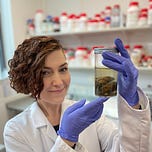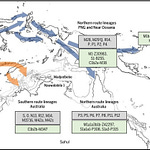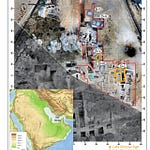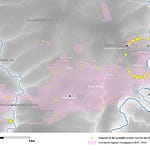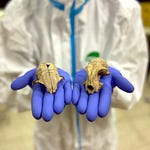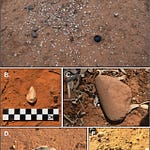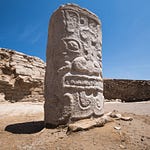At a forgotten cemetery in Bristol, England, buried under the ruins of a 19th-century workhouse hospital, archaeologists unearthed something rare—human brains. Not mummies. Not bog bodies. Just soft, shriveled, centuries-old brains, unexpectedly intact. What these brains carried wasn't just the silent history of anonymous lives but a molecular archive that science has long struggled to access: the deep, hidden record of ancient human proteins.

Until recently, ancient soft tissues like brain, liver, or stomach were considered almost unusable for molecular analysis. Bones and teeth—yes. But the fragile complexity of internal organs? Not a chance. That tide has now shifted, thanks to new methods in paleoproteomics developed by researchers at the University of Oxford. Their results, published in PLOS ONE1 in May 2025, represent the most expansive protein profile ever recovered from archaeological soft tissue.
“Only about 10% of human proteins are expressed in bone,” noted the research team, “while more than 75% occur in internal organs. These soft tissues contain a far richer biological signature.”
By unlocking ancient soft tissues, the researchers opened a biochemical window into human life previously out of reach.
The Experiment: A Brain from a Workhouse
The team’s focal sample was SK 17999, an individual excavated from the grounds of the former Blackberry Hill Hospital in Bristol. Built atop a prison and later repurposed as a cholera hospital and workhouse, the site offers a unique historical blend of suffering, resilience, and forgotten lives. Remarkably, this individual’s brain was so well preserved that its sulci and gyri—the folds of the cerebral cortex—remained visible.
Ten subsamples of the brain were subjected to various protein extraction and clean-up protocols. Each method attempted to crack open the tightly coiled world of ancient molecules without destroying them.
One surprising winner? Urea. Yes, the same chemical found in urine.
“Urea lysis proved the most effective at breaking down preserved membrane structures, releasing a wider range of intracellular proteins, including those from the mitochondria and cytoskeleton,” according to the research findings.
This method delivered over 1,200 unique proteins, dwarfing the recovery from more traditional methods used for bones and teeth.
What the Proteins Reveal
Ancient proteins survive by folding into compact, stable shapes. Their resilience makes them ideal for tracking both the genetic and lived experience of past populations. And while DNA tells us what could be, proteins show what actually was—from disease and diet to brain function and possibly even mental health.
Among the findings were:
Cytoskeletal proteins, such as tubulins and intermediate filaments, which were significantly enriched.
Myelin proteolipid proteins, pointing to possible preservation of brain-specific neurological features.
Evidence of diagenetic modifications, including deamidation and unusual peptide cleavage, which reflect both degradation over time and post-mortem chemical changes.
These protein "fingerprints" not only reveal aspects of brain physiology but also how ancient environments affected the chemical stability of soft tissues.
“The brain proteome is an order of magnitude more diverse than bone. This method helps capture that complexity,” the researchers wrote.
Why This Matters
This isn’t just a technical achievement. It’s a shift in what’s possible. Soft tissues, once dismissed as too fragile or contaminated for meaningful analysis, now offer a pathway to understanding disease, aging, diet, and social stress in ancient populations.
And because proteins can survive where DNA degrades, especially in acidic or warm environments, they could be pivotal in expanding bioarchaeological studies beyond the narrow corridor of well-preserved mummies or cold-climate remains.
For anthropologists and archaeologists, this means new lines of inquiry:
What biomarkers of neurological disease can be detected in ancient populations?
Can we use brain proteomics to explore the evolution of cognition or neurodegenerative disorders?
How did post-mortem preservation differ across time periods, burial contexts, and climates?
Social Memory and Scientific Method
At a deeper level, these studies also touch on memory—both cultural and molecular. Brains are not just sites of thought and identity; in death, they may also preserve traces of societal conditions and lived experiences.
In this way, paleoproteomics becomes more than just an analytical method. It’s a mode of listening—to lives long past, etched not in inscriptions or oral history, but in folded proteins and biochemical scars.
Further Reading: Related Research
Hendy, J., Warinner, C., et al. (2018). Proteomic evidence of dietary sources in prehistoric dental calculus. Nature Communications, 9, 3217. https://doi.org/10.1038/s41467-018-05681-0
Cappellini, E., Welker, F., et al. (2019). Ancient biomolecules and evolutionary inference. Annual Review of Biochemistry, 88, 653–683. https://doi.org/10.1146/annurev-biochem-013118-111817
Demarchi, B., Hall, S., et al. (2016). Protein sequences bound to mineral surfaces persist into deep time. eLife, 5, e17092. https://doi.org/10.7554/eLife.17092
Jersie-Christensen, R. R., et al. (2018). Paleoproteomics of the Cheddar Man: A British Mesolithic male. Journal of Proteome Research, 17(3), 1023–1032. https://doi.org/10.1021/acs.jproteome.7b00847
Warinner, C., et al. (2015). Pathogens and host immunity in the ancient human oral cavity. Nature Genetics, 47(4), 336–344. https://doi.org/10.1038/ng.3260
Morton-Hayward, A., Flannery, S., Vendrell, I., & Fischer, R. (2025). Deep palaeoproteomic profiling of archaeological human brains. PloS One, 20(5), e0324246. https://doi.org/10.1371/journal.pone.0324246

